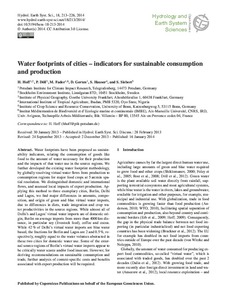| dc.contributor.author | Hoff, H. |
| dc.contributor.author | Döll, P. |
| dc.contributor.author | Fader, M. |
| dc.contributor.author | Gerten, D. |
| dc.contributor.author | Hauser, S. |
| dc.contributor.author | Siebert, S. |
| dc.date.accessioned | 2019-12-04T10:58:27Z |
| dc.date.available | 2019-12-04T10:58:27Z |
| dc.date.issued | 2014 |
| dc.identifier.citation | Hoff, H., Döll, P., Fader, M., Gerten, D., Hauser, S. & Siebert, S. (2014). Water footprints of cities–indicators for sustainable consumption and production. Hydrology and Earth System Sciences, 18(1), 213-226. |
| dc.identifier.issn | 1027-5606 |
| dc.identifier.uri | https://hdl.handle.net/20.500.12478/992 |
| dc.description.abstract | Water footprints have been proposed as sustainabilityindicators, relating the consumption of goods likefood to the amount of water necessary for their productionand the impacts of that water use in the source regions. Wefurther developed the existing water footprint methodology,by globally resolving virtual water flows from production toconsumption regions for major food crops at 5 arcmin spatialresolution. We distinguished domestic and internationalflows, and assessed local impacts of export production. Applyingthis method to three exemplary cities, Berlin, Delhiand Lagos, we find major differences in amounts, composition,and origin of green and blue virtual water imports,due to differences in diets, trade integration and crop waterproductivities in the source regions. While almost all ofDelhi’s and Lagos’ virtual water imports are of domestic origin,Berlin on average imports from more than 4000 km distance,in particular soy (livestock feed), coffee and cocoa.While 42% of Delhi’s virtual water imports are blue waterbased, the fractions for Berlin and Lagos are 2 and 0.5 %, respectively,roughly equal to the water volumes abstracted inthese two cities for domestic water use. Some of the externalsource regions of Berlin’s virtual water imports appear tobe critically water scarce and/or food insecure. However, forderiving recommendations on sustainable consumption andtrade, further analysis of context-specific costs and benefitsassociated with export production will be required. |
| dc.format.extent | 213-226 |
| dc.language.iso | en |
| dc.subject | Virtual Water |
| dc.subject | Production |
| dc.subject | Consumption |
| dc.title | Water footprints of cities indicators for sustainable consumption and production |
| dc.type | Journal Article |
| dc.description.version | Peer Review |
| cg.contributor.affiliation | Potsdam Institute for Climate Impact Research |
| cg.contributor.affiliation | Stockholm Environment Institute |
| cg.contributor.affiliation | Goethe University |
| cg.contributor.affiliation | International Institute of Tropical Agriculture |
| cg.contributor.affiliation | University of Bonn |
| cg.contributor.affiliation | Université d'Aix-Marseille |
| cg.coverage.region | Africa South Of Sahara |
| cg.coverage.country | Nigeria |
| cg.isijournal | ISI Journal |
| cg.authorship.types | CGIAR and advanced research institute |
| cg.journal | Hydrology and Earth System Sciences |
| cg.howpublished | Formally Published |
| cg.accessibilitystatus | Open Access |
| local.dspaceid | 77921 |
| cg.identifier.doi | https://dx.doi.org/10.5194/hess-18-213-2014 |

